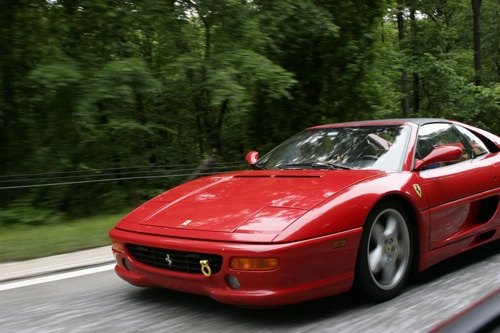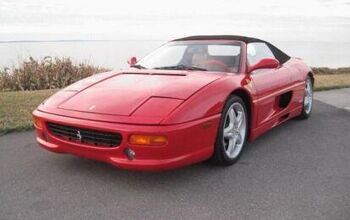Review: Ferrari F355

Forget, for a moment, that we are behind the wheel of a Ferrari, and possibly the best mid-engined road Ferrari in history at that. Forget the scenery, which is beautiful, and the road, which is slick with rain and therefore rather difficult to forget. Forget the speed, which is, frankly, excessive, and forget the Mustang ahead of you, swelling in your windshield at a that’s-no-moon-it’s-a-space-station pace. Take a moment and listen.
The sound directly behind you is a flat-crank, forty-valve, titanium-connecting-rod vee-eight spinning at over eight thousand revolutions per minute. It’s not a traditional V8 musclecar sound. Instead, you hear a doubled four-cylinder, overdubbed like an Eighties Iron Maiden record to the left and right. It isn’t smooth, and it isn’t melodious, but it is absolutely compelling. There is nothing else like it.
Other cars offer the look, the performance, even the prestige, but none offer the sound. You’re at redline now. Open your senses, let it all come rushing back—the unfettered thrill of operating this peerless car, on this day, at full throttle—and select fifth gear. Gone.
Performance Rentals Incorporated, based in New York and providing service as far as Boston and Washington, D.C., offers seven different fascinating vehicles for daily or weekly rental, including a 750-horsepower supercharged third-gen Viper which they bill as “The fastest car available for rent in North America.” Compared to that Viper, this Ferrari is merely quick, but against unmodified modern cars the decade-old F355 can still hold its own.
The quoted thirteen-seconds-flat quarter-mile time feels easily achievable in this particular example, and the engine revs with a light-flywheel willingness almost unknown in emissions-compliant automobiles. Compared to my Porsche 993, which hails from the same era, the Ferrari pulls with less authority from low revs but easily outpaces the Super Beetle once the tach swings past the “50” mark.
Inside, it’s a thin-pillar retro delight. The metal-gated shifter performs just as one would expect, adding a solid “clank” to each throw, while the steering and brakes are new-car tight and responsive. Visibility is surprisingly good, far better than what one would find in a Corvette or Viper. The fruits of Luca di Montezemolo’s famous dictate to “make this an everyday Ferrari” are evident everywhere, from the easy-to-understand climate controls to the superb amount of shoulder room.
While the F355 traces its stylistic roots to Pininfarina’s 308GTS, the driving position and view from the cockpit are actually far closer to what one would find in the Bertone 308GT4. There, as here, one has a slight sense of sitting at the very forward end of the car, perched over the front wheels and quite close to the road rushing by beneath. It’s the complete antithesis of a front-engined Ferrari and one quickly understands why individual tifosi are rarely fans of both the Dino descendants and Daytona successors.
Most car enthusiasts who have never driven a Ferrari in real life imagine the driving experience provided by the mid-engined Fezzas to be Corvetteish, but the reality is best expressed by the fact that the driver of an F355 cannot stick his left leg straight out without kicking the left front wheelwell. By comparison, a Boxster feels positively cab-backwards.
The majority of the F-car rentals in this country are either tired old 360 Modenas or hyper-expensive F430s, but PRI chose the F355 in keeping with their philosophy of offering “performance-tuned drivers’ cars.” A perforated “Challenge” rear grille hints at the upgraded suspension, brakes, and retuned engine mapping. Every bushing in the suspension is up to spec, every bit of interior trim is freshened to new-car standards, and a reasonably complete, iPod-compatible sound system has been installed.
To be fair, I don’t know if it works, because I didn’t bother to turn it on, and you wouldn’t, either.
The F355 is probably the “best” modern Ferrari in the same way that the Porsche 993 is the “best” modern Porsche. In both cases, technology, usability, and character combine to provide a driving experience which feels suitably flavorful without the annoyances of Bosch K-Jetronic or bias-ply tires.
There’s enough performance on tap here to thrill (or kill) you three times over, it’s so good-looking that it’s virtually impossible to walk away without an oh-so-stereotypical backwards glance, and there’s no SUPER-DSC-ATTESSA-HICAS to save the untalented from their own shortcomings. Really, this is the Ferrari you want to drive, should you drive just one.
PRI’s daily rate for the F355 is just slightly under a thousand dollars a day. I can think of a few other ways for a gearhead to spend that kind of money, from a one-day class at the Mid-Ohio school to a set of Hoosier R6 tires for one’s track car, but the moment the Ferrari’s tach shows eight grand, you’ll forget there were any other choices.
[ Performance Rentals Incorporated provided the vehicle tested, insurance and gas]
More by Jack Baruth
Latest Car Reviews
Read moreLatest Product Reviews
Read moreRecent Comments
- Jeff Self driving cars are not ready for prime time.
- Lichtronamo Watch as the non-us based automakers shift more production to Mexico in the future.
- 28-Cars-Later " Electrek recently dug around in Tesla’s online parts catalog and found that the windshield costs a whopping $1,900 to replace.To be fair, that’s around what a Mercedes S-Class or Rivian windshield costs, but the Tesla’s glass is unique because of its shape. It’s also worth noting that most insurance plans have glass replacement options that can make the repair a low- or zero-cost issue. "Now I understand why my insurance is so high despite no claims for years and about 7,500 annual miles between three cars.
- AMcA My theory is that that when the Big 3 gave away the store to the UAW in the last contract, there was a side deal in which the UAW promised to go after the non-organized transplant plants. Even the UAW understands that if the wage differential gets too high it's gonna kill the golden goose.
- MKizzy Why else does range matter? Because in the EV advocate's dream scenario of a post-ICE future, the average multi-car household will find itself with more EVs in their garages and driveways than places to plug them in or the capacity to charge then all at once without significant electrical upgrades. Unless each vehicle has enough range to allow for multiple days without plugging in, fighting over charging access in multi-EV households will be right up there with finances for causes of domestic strife.




































Comments
Join the conversation
Excellent article! I know that there are faster cars but you are right in the fact that just the prestige of driving such a stunning car is much better.
What a fugly car. Built for people with so much money they can afford to drive crap. In 10 years the only ones of these that will be left will be ones with flux capacitors installed in them.